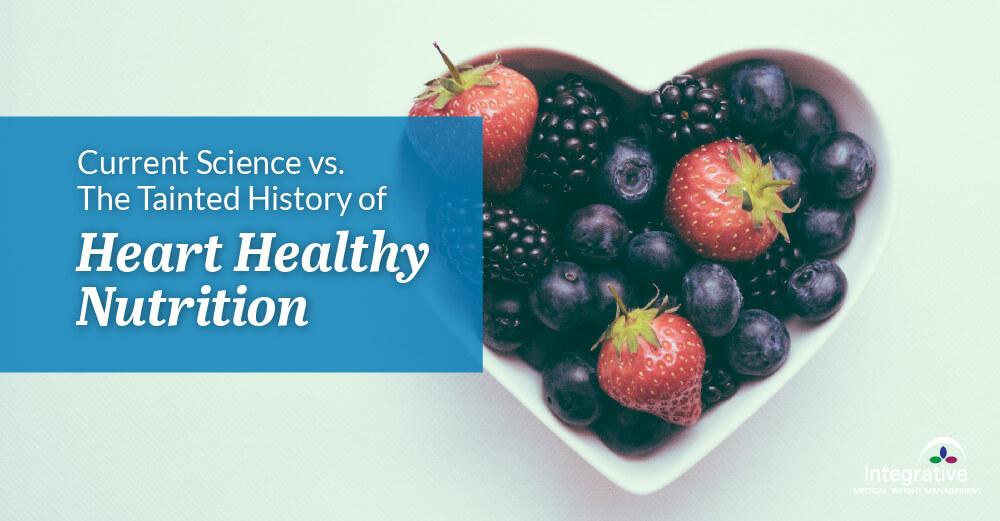Your first heart cells begin beating four weeks after conception and don’t stop until you take your last breath.
This coordinated effort happens 100,000 times a day, beat after beat, without rest.
Each time I lay my stethoscope over the heart’s pulsating chambers, I marvel at its faithful, steady beat.
As a medical weight loss specialist, my goal is to keep hearts ticking in top form. I share this goal with my patients, who cite heart health as one of their most powerful motivators for weight loss and overall health improvement.
While many factors influence heart health, none are talked about as much as food.
It’s for good reason: food is one of the most powerful substances that we put into our bodies. It can have both positive and negative effects on the heart.
I prescribe low carbohydrate eating because it has been proven to be optimal for heart health.
Low carbohydrate eating reduces or eliminates many of the risk factors for heart disease—type II diabetes, prediabetes, insulin resistance, elevated blood fats, elevated blood pressure, and inflammation. And it induces weight loss, which in itself is good for the heart.
It’s not just medical journals and professional presentations that prove these benefits—I see it every day in my clinical practice.
When patients reduce their intake of refined grains and added sugar and replace them with whole foods, I see reductions in:
- Blood Sugar
- Insulin
- Triglycerides
- LDL Particles
- Blood Pressure
- Inflammation
- Fatty Liver Disease
When people add meat, eggs, cheese, butter, olives, and nuts to their diets, their waists get smaller and they get healthier.
I know this flies in the face of the low-fat dogma that’s been pushed since the 1970s.
But a growing body of evidence suggests that low-fat, high carbohydrate eating is anything but “heart healthy.”
Two prominent physicians, Robert Lustig and David Ludwig have called it “an experiment that failed.”
The Heart Health Experiment that Failed
In an effort to curb the rising rates of cardiovascular disease in the 1970s, scientists rolled out new dietary guidelines that emphasized the dangers of dietary fat.
We were told that fat would clog our arteries, cause heart disease, and make us fat. Not only was fat bad, saturated fat was the biggest villain of them all. We should avoid or limit it at all costs, and replace it with refined grains and foods with added sugar.
As a result, low-fat, high carbohydrate eating became synonymous with “heart healthy” eating. It seemed to make sense, and people parrot the mantra to this day.
The problem was that it was wrong.
In the era of low-fat eating, heart disease rates went up, not down. The same was true for type II diabetes and obesity.
So why did the experiment fail?
For starters, it was never based on credible science.
Faulty Science & Suppression of Evidence
The vilification of fat began in the 1960s when Ancel Keys published his landmark “Seven Countries” study, which claimed that populations who ate low-fat diets had lower rates of cardiovascular disease.
The problem was that Dr. Keys omitted data from countries where the opposite was true—high fat diets were correlated with low rates of cardiovascular disease. And his data was gleaned from epidemiologic studies, not clinical trials.
Epidemiologic studies seek to identify influential factors in a disease, but do not identify causes.
Despite this important distinction, Dr. Keys made a leap, insisting that dietary fat caused cardiovascular disease.
In the ensuing years, Dr. Keys and others suppressed data that contradicted his theory and attacked researchers whose results did not support his views.
One of the main players was the sugar industry.
In September 2016, the Journal of the American Medical Association published a well-researched article revealing that in the 1960s, the sugar industry paid Harvard scientists to publish industry-funded studies which downplayed the role of sugar in cardiovascular disease, and pointed the finger at fat.
If you are interested in learning more about the history of low-fat recommendations and the suppression of contrary evidence, here are some credible and riveting resources:
- A Big Fat Surprise by Nina Teicholz
- Why We Get Fat by Gary Taubes
- Good Calories, Bad Calories by Gary Taubes
Once the fictional storyline was set that fat was bad for us, the vast majority of researchers set out to prove the theory. The bias was so strong that even when the data did not suggest that low-fat eating reduced cardiovascular disease, study authors and nutrition boards still recommended it.
This is not credible science.
While low-fat eating was being pushed by the mainstream, some scientists questioned it. With a hypothesis that low carbohydrate eating was more beneficial, they designed new studies. But their proposals were not accepted or funded.
Despite the hurdles, some conducted research, finding that low carbohydrate eating lowered risk factors for cardiovascular disease. But the major medical journals wouldn’t publish their data. Their findings were relegated to small journals that were not read by the mainstream medical or research community.
Fortunately, that is changing…
Emerging Science
Between 1993 and 1998, the Women’s Health Initiative enrolled nearly 49,000 women between the ages of 50-79 in a study to determine if a low-fat diet would reduce cardiovascular disease.
This multi-center, randomized clinical trial was the largest ever completed. Its results, published in 2006, were stunning. Not only did they find no reduction in rates of cardiovascular disease, but there was also no reduction in rates of breast cancer, colorectal cancer, or weight.
Other major studies have had similar findings, including one published in the New England Journal of Medicine in 2013. In this study, about 7,500 participants were randomized to a low-fat diet or to a Mediterranean-style diet that included more fat. This trial was halted early when the data overwhelmingly showed that the low-fat group had higher rates of cardiovascular disease.
As a result of these landmark studies, the paradigm is shifting.
More clinicians and national guidelines are welcoming fat into nutritional science.
The 2015-2020 Dietary Guidelines for Americans shifted the recommendations from limiting fat to limiting saturated fat. This was a step in the right direction. But it wasn’t far enough for the nutrition scientists and clinicians who believe saturated fat is actually the most beneficial type of fat.
Today there are more clinical trials underway than ever before, which are testing the effects of low carbohydrate eating on health and risk reduction. And medical journals are publishing them.
The Real Villain
Focusing on fat as a villain kept us in the dark about other dietary influences that pose their own health risks, particularly sugar and refined grains.
Refined carbohydrates—including sugar in all forms, starchy foods, and processed grains—contribute to insulin resistance and widespread inflammation. They rapidly flood the bloodstream with glucose, stimulating an insulin response. As insulin levels rise, glucose converts to fat, particularly around the waist.
This leads to increased rates of:
- Type II Diabetes
- Pre-diabetes
- Cardiovascular Disease
- Stroke
- Cancer
- Fatty Liver Disease
- And others…
When fat was reduced or removed, food manufacturers added sugar to make their products more appealing. This created a surge of non-fat, high sugar foods that no doubt contributed to the skyrocketing rates of obesity, diabetes, and cardiovascular disease that we’ve seen in the past thirty years.
Another problem with refined carbohydrates is their addictive nature. They stimulate hunger hormones and disable satiety signals. Even small amounts can hook the brain into wanting them, typically in increasing amounts. Reward centers in the brain are activated and cravings become more intense, resulting in a cycle that many find difficult to stop.
For example, non-fat yogurt was marketed as health food, despite the fact that it was loaded with sugar.
Because there was no fat to signal satiety, and there was plenty of sugar to stimulate cravings, people had difficulty limiting their portions. This led them to eat more, which further stimulated insulin and did not satisfy their hunger.
This was only one of the many “non-fat health foods” that flooded the market. Even those that didn’t contain sugar, such as pretzels, crackers, and bread, caused a similar response.
Low Carbohydrate Eating
Low carbohydrate eating is what’s left after processed foods, sugars, and grains are removed from the diet.
Some have called it a fad, but what is faddish about eating whole foods such as eggs, meat, nuts, seeds, vegetables, and fruit?
Low Carbohydrate eating is a broad category of dietary approaches that fall on a spectrum between 10-100 grams of carbohydrates per day. All restrict or eliminate the consumption of refined carbohydrates, grains, starchy vegetables, and sugars. Some emphasize the consumption of fat, while others focus on protein.
Very low carbohydrate eating, also known as ketogenic or carb-restricted eating, is a special type of low carbohydrate eating defined as limiting carbohydrates significantly to achieve a state of ketosis. Limiting carbs to 20-50 grams per day or less is required. Carbohydrates are restricted to low carbohydrate vegetables and select berries.
Prior to the development of insulin shots, doctors treated diabetes with very low carbohydrate, high fat, moderate protein diets. Because diabetes is a condition of carbohydrate intolerance, carbohydrate intake was limited to no more than 10 grams per day.
For those with severe insulin resistance, even small amounts of refined grains and sugar can cause insulin to spike. This results in fat storage at the waistline, in the liver, and in the blood.
The decision about how severely to restrict carbohydrates should be made based on your health, risk factors, personal preference, and your healthcare professional’s recommendations.
For more information about low carbohydrate eating, I recommend the following books and websites:
- The Art & Science of Low Carbohydrate Living by Jeff Volek, Ph.D., RD & Stephen Phinney, MD, PhD
- The Low Carb Dietician’s Guide to Health & Beauty by Franzisca Spritzler, RD, CDE. Website: https://www.lowcarbdietitian.com/
- Diet Doctor (dietdoctor.com) by Andreas Eenfeldt, MD
Where Do We Go From Here?
I hope that the research will continue and that the results will be disseminated to all the players in the nutrition world—clinicians, advisory boards, policymakers, and the public. There are too many contradictory voices out there.
Until we are all on the same page, public health will suffer.
There are five critical changes that need to happen to shift national heart health in the right direction, save lives, and restore trust:
1. Nutrition scientists must avoid the corruption and bias that plagued the low-fat era
We have to be vigilant so that we don’t repeat this public health disaster. We need to do credible science and insist on transparency in clinical trials, medical education, and nutritional guidelines. We need to rebuild the trust of the public and the medical community.
2. Every patient needs to be told about the heart-healthy benefits of low carbohydrate eating
Despite evidence to the contrary, far too many clinicians and nutrition boards continue to tout low-fat eating as “heart-healthy.” Every person who desires a healthy heart should get science-based guidance about nutrition from every member of the nutrition team, which includes the heart-healthy benefits of low carbohydrate eating.
3. Dietary guidelines should be updated to reflect current science
Our institutions and government agencies need to create guidelines that reflect current science. Until they do, people will continue to hear conflicting advice and the confusion will continue.
4. “Heart Healthy” symbols need to be put on low carbohydrate foods, not low-fat
Heart-healthy symbols need to be removed from low-fat, high carbohydrate food packages and restaurant menu items. Those symbols rightfully belong to low carbohydrate foods such as eggs, butter, cheese, nuts, olives, vegetables, and fruit.
5. We need a massive reduction of processed carbohydrates in our stores, restaurants, schools, and workplaces.
They pose a public health risk that affects every person in society.
I hope that these changes will be instituted soon so every heart will beat in top form. Low carbohydrate eating is the first step to making that happen.
Further Resources on the Topic:
- Always Hungry by David Ludwig, 2016
- Don’t Blame Fat by Bryan Walsh. Time Magazine, June 23, 2014.
- Fat Chance by Robert Lustig, 2012
- Good Calories, Bad Calories by Gary Taubes, 2008
- How the Sugar Industry Shifted Blame to Fat by Anahad O’Connor. New YorkTimes, 9-13-16
- Low Fat Dietary Pattern & Risk of Cardiovascular Disease by Howard, Van Horn, Hsia, et al, 2006. JAMA 2006; 295(6):655-666.
- Primary Prevention of Cardiovascular Disease with a Mediterranean Diet by Estrich, et al, 2013. NEJM 2013; 368: 1279-1290.
- Saturated Fat Is Not The Major Issue by Aseem Malhotra, MD. British Medical Journal 2013; 347;16340
- Sugar Industry & Coronary Heart Disease Research by Kearns, Schmidt, & Glantz, 2016. JAMA Internal Medicine, 2016; 176(11):1680-1685
- The Art & Science of Low Carbohydrate Living by Jeff Volek & Stephen Phinney, 2011
- The Big Fat Surprise: Why Butter, Meat & Cheese Belong in a Healthy Diet by Nina Teicholz, 2014
- The Low Carb Dietician’s Guide to Health & Beauty by Franziska Spritzler, 2015
- Wheat Belly by William Davis, 2011
- Why We Get Fat: And What to Do About It by Gary Taubes, 2011



